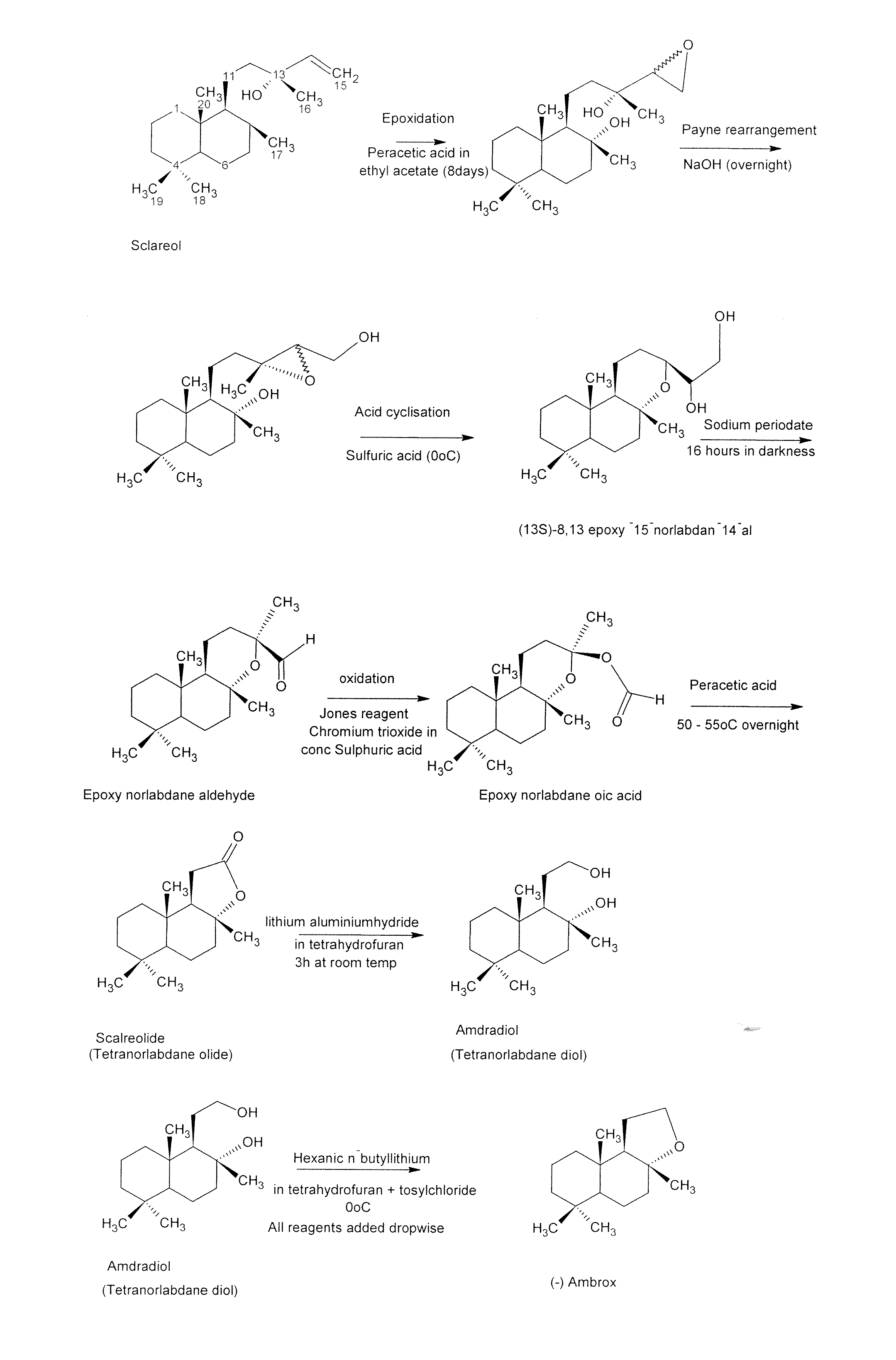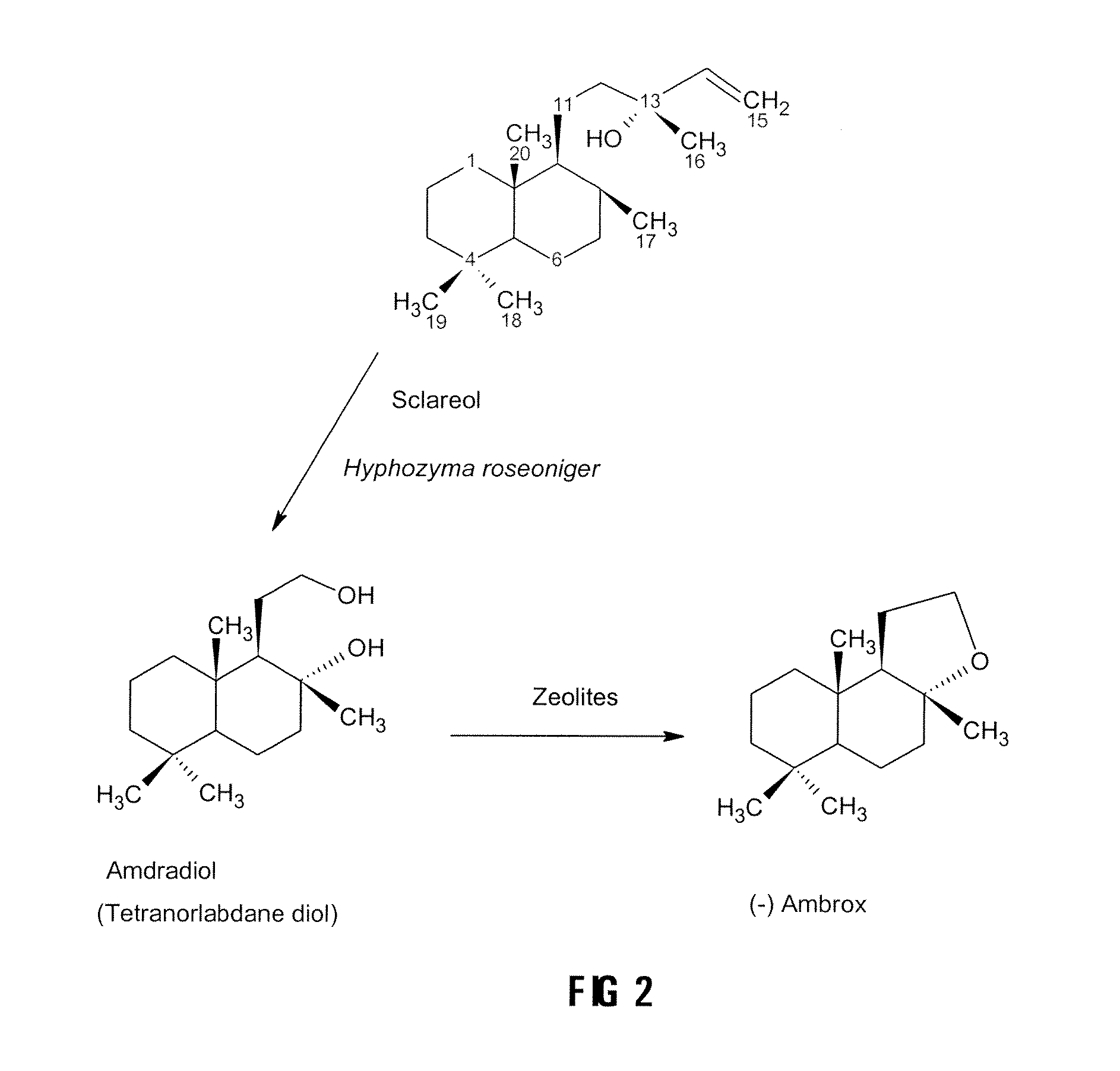Process for the Production of Ambrafuran
a technology of ambrafuran and ambrafuran, which is applied in the field of ambrafuran production process, can solve the problems of expensive processes, and achieve the effects of reducing the rate of evaporation of volatile substances, reducing density, and stabilizing perfumes
- Summary
- Abstract
- Description
- Claims
- Application Information
AI Technical Summary
Benefits of technology
Problems solved by technology
Method used
Image
Examples
example 2
Production of the Intermediate Diol from Sclareol Using Hyphozyma roseoniger
Reconstituting the Microorganism
[0031]The Hyphozyma roseoniger was purchased from ATCC in a freeze-dried powder form. It was reconstituted in sterile water and inoculated onto agar plates. The agar plates consisted of potato dextrose agar and the yeast cultivation medium. The plates were grown for 4 days at room temperature. The microorganism was streaked onto another set of plates to ascertain purity of the culture. It was then inoculated into broth consisting of the yeast cultivation medium. It was grown for 3 days and the cells were spun down and re-suspended in a minimal volume of 100 mM potassium phosphate buffer, pH6.5. The cell suspension was mixed with an equal volume of 50% glycerol and then placed into cryovials as the master cell bank.
[0032]All experiments were carried out using a vial from the master cell bank. Microorganism (500 μl) was inoculated into 10 ml of either potato dextrose broth (PDB...
example 3
Preparation of the Zeolites
[0041]Inactive zeolites NaY type from Zeolyst (25 g) was mixed with 250 ml 10% ammonium nitrate and ion exchanged by refluxing at 90° C. for 24 hours. The mixture was filtered, washed with distilled water and dried overnight at 105° C. The procedure was repeated with 10% calcium nitrate and the zeolite was then activated at approximately 500° C. under vacuum.
[0042]Alternatively the Zeolite CBV320 (CaY type) can be purchased from Zeolyst International in the inactivate form and can be activated under vacuum at 500° C.
[0043]Yet another alternative was to activate the Zeolite CBV320 in a conventional microwave oven. The preferred method was to activate 50 g of Zeolite CBV320 by heating at 500 W for 15 minutes in an open container in the microwave. The Zeolites were allowed to cool and then kept in a closed container
example 4
Conversion of the Diol to (−)Ambrafuran
[0044]The conversion of the diol to the (−) ambrafuran was accomplished by cyclodehydration. Approximately 10 to 50 mg of the intermediate diol, prepared from sclareol with the Hyphozyma roseoniger microorganism as described above was, in different embodiments of the invention, dissolved in 10 ml of toluene, ethyl acetate, diethyl ether, ethanol or hexane and placed in a round bottom flask. Activated zeolite (10 mg to 500 mg), prepared as described above, was added and the mixture was allowed to react at temperatures ranging from room temperature to 110° C. for 1 to 24 hours. The results are set out in Table 1 below.
TABLE 1Conversion of the diol to (−) ambrafuran with differentsolvents in 4 hours at room temperatureSolventConversion (4 hours)Diethyl ether25Ethanol5.4Ethyl acetate3.7Toluene100Hexane100
[0045]In another embodiment of the invention, the reaction was carried out at room temperature for 1 to 4 hours in toluene with a ratio of 400 mg ...
PUM
 Login to View More
Login to View More Abstract
Description
Claims
Application Information
 Login to View More
Login to View More - R&D
- Intellectual Property
- Life Sciences
- Materials
- Tech Scout
- Unparalleled Data Quality
- Higher Quality Content
- 60% Fewer Hallucinations
Browse by: Latest US Patents, China's latest patents, Technical Efficacy Thesaurus, Application Domain, Technology Topic, Popular Technical Reports.
© 2025 PatSnap. All rights reserved.Legal|Privacy policy|Modern Slavery Act Transparency Statement|Sitemap|About US| Contact US: help@patsnap.com



